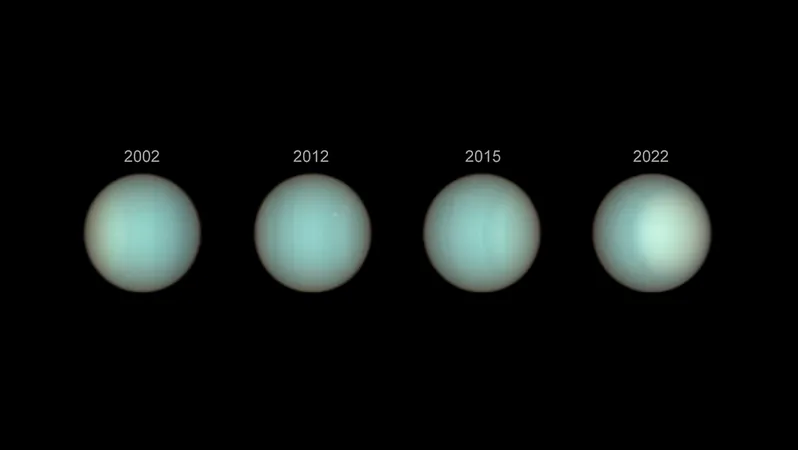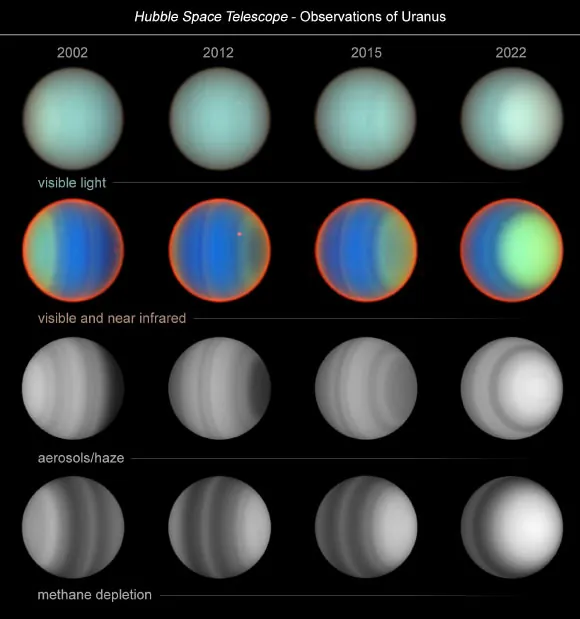
Groundbreaking Hubble Study Reveals Secrets of Uranus' Mystifying Atmosphere
2025-04-02
Author: John Tan
The enigmatic ice giant Uranus, with its unique sideways rotation, continues to intrigue scientists as new revelations emerge from a groundbreaking 20-year study utilizing NASA's Hubble Space Telescope. This remarkable research has elucidated the complexities of Uranus's atmospheric composition and dynamics, showcasing just how crucial long-term observations are for understanding this distant world.
Since Voyager 2's iconic flyby in 1986, which depicted Uranus as a featureless blue-green sphere, Hubble has transformed our comprehension of the planet's seasonal shifts. A dedicated team of astronomers, led by Erich Karkoschka from the University of Arizona and collaborators from the University of Wisconsin, has leveraged Hubble's advanced capabilities, particularly its Space Telescope Imaging Spectrograph (STIS), to meticulously document Uranus’s atmosphere across multiple observation periods: 2002, 2012, 2015, and 2022.
The findings reveal that the primary components of Uranus's atmosphere consist of hydrogen and helium, along with significant traces of methane, water, and ammonia. Methane plays a crucial role in the planet’s distinctive cyan hue by absorbing red light from the Sun. However, unlike its gas giant counterparts Saturn and Jupiter, the distribution of methane on Uranus is notably uneven, exhibiting a pronounced depletion near the poles—a pattern that has been stable over the two decades of observation.
Intriguingly, the study highlights a striking transformation in the atmospheric haze over time, especially in the northern polar region, which has brightened considerably as Uranus approaches its northern summer solstice in 2030. As Uranus completes its lengthy 84-year orbit around the Sun, Hubble's observations have primarily captured the gradual transition toward northern spring. This period marks a shift in sunlight from directly illuminating the equator to predominantly reaching the north pole—a change that unveils complex atmospheric circulation patterns, with evidence of downwelling in polar regions and upwelling elsewhere.
Visual representations of Uranus from Hubble illustrate these seasonal dynamics: the first row captures the planet's appearance in visible light, akin to what one might see through a basic telescope. Other rows employ false-color images created from both visible and near-infrared data, revealing nuanced details about methane and aerosol concentrations across varying latitudes.
This decade-spanning project has highlighted not only the solid structure of methane and aerosols but also their response to solar radiation, delineating how these atmospheric elements interplay. For instance, while aerosols displayed a marked increase around the north pole, indicating changing cloud conditions, methane's depletion remained consistent, particularly stark at high latitudes.
As Uranus continues to approach its northern summer, astronomers are poised to conduct further observations, anticipating additional insights into this intriguing planet's behavior.
The Hubble Space Telescope, a landmark accomplishment of international collaboration between NASA and the European Space Agency (ESA), has been breaking ground in astronomical research for over 30 years. Managed by NASA's Goddard Space Flight Center, and supported by Lockheed Martin and the Space Telescope Science Institute, Hubble's relentless quest for knowledge perpetually enriches our understanding of the universe and the intricate dynamics at play on planets like Uranus.
Stay tuned as more revelations about Uranus and its atmospheric secrets are unveiled—this ice giant is full of surprises!



 Brasil (PT)
Brasil (PT)
 Canada (EN)
Canada (EN)
 Chile (ES)
Chile (ES)
 Česko (CS)
Česko (CS)
 대한민국 (KO)
대한민국 (KO)
 España (ES)
España (ES)
 France (FR)
France (FR)
 Hong Kong (EN)
Hong Kong (EN)
 Italia (IT)
Italia (IT)
 日本 (JA)
日本 (JA)
 Magyarország (HU)
Magyarország (HU)
 Norge (NO)
Norge (NO)
 Polska (PL)
Polska (PL)
 Schweiz (DE)
Schweiz (DE)
 Singapore (EN)
Singapore (EN)
 Sverige (SV)
Sverige (SV)
 Suomi (FI)
Suomi (FI)
 Türkiye (TR)
Türkiye (TR)
 الإمارات العربية المتحدة (AR)
الإمارات العربية المتحدة (AR)